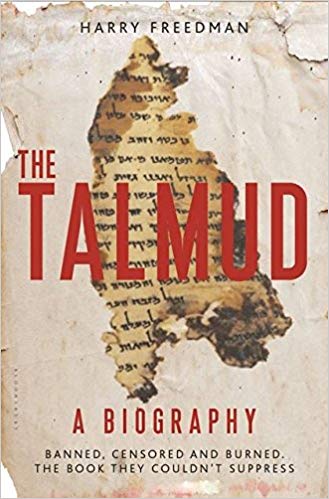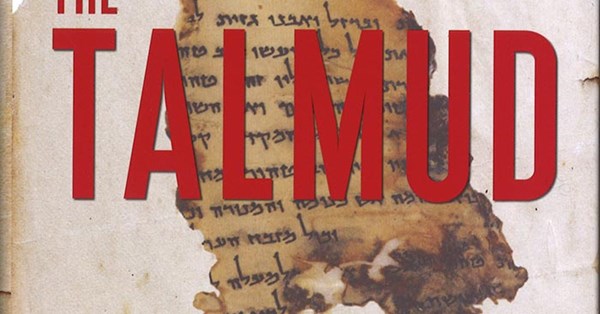The Talmud, a Biography: Banned, Censored and Burned, the Book They Couldn’t Suppress by Harry Freedman, Bloomsbury, 2014
I ordered this book from good old Bibliophile in an attempt to broaden my education. I feel I have learned a lot, but whether it will stay in my mem ory is another matter.
ory is another matter.
According to the author’s Preface, it is the Talmud, rather than the Bible, which defines the religion of the Jews, and in fact the Jews themselves.
In tracing the origins and development of the Talmud over the millennia in which it has existed in one form or another (first oral, then written, and eventually printed), Harry Freedman, a historian and expert in Aramaic and Judaic studies, introduces us to the different environments and cultures in which the Talmud emerged and eventually flourished, as well as giving us insights into the various rabbis, interpreters, and scholars who helped to formulate and establish it.
The Talmud has its roots in biblical exegesis in both ancient Israel and ancient Babylon, the latter being the community established by the Jews originally brought there forcibly by Nebuchadnezzer II after the destruction of the First Temple in 586 BCE (remember the plaintive refrain ‘By the rivers of Babylon, there we sat down and wept’?). When Cyrus, the Persian ruler who conquered Babylon, permitted the Jews to return to their homeland about fifty years later, many Jews chose to remain in the land of their exile where they had established their homes, families and apparently also their livelihoods. Thus, the two centers of learning, in Judea and Babylon, developed two traditions of Bible interpretation.
In essence, the Babylonian Talmud is considered to be preeminent, although both Talmuds consist of discussions among scholars of the meaning and implementation of laws contained in the Bible and interpreted in the Mishna, even though these discussions may have taken place at different times and in different places. During the sixth and seventh centuries CE editors collected and collated them into a cohesive whole, formulating them in a way that has endured to this day.
In effect, citing Rabbi Louis Jacobs, the author defines the Talmud as “a literary construction in which debates, opinions, proofs, and rulings that took place over nearly three hundred years are woven together by later editors into a coherent whole.” The central column, written in Hebrew or Aramaic, of a page of Talmud, in a slightly larger font than the columns of text on either side, consists of the text of the Mishna and the Talmudic commentaries on it. The columns on either side contain the commentaries of Rashi, the great eleventh-century French commentator, while the outer column contains the commentaries of the tosafists, scholars from different, earlier periods. Interspersed with these rabbinical discussions are legends and tales which supposedly illustrate aspects of the text, or simply contain an illuminating diversion from the scholarly exegesis.
Most of the Talmud is based on a record of discussions held in the rabbinic academies in Babylon between the years 230 and 500 CE. Thus, we are introduced to such rabbinic luminaries as Yehudai Gaon, Pirkoi ben Baboi, Saadia Gaon of Sura and many others. In the period after the decline and fall of Babylon, the centers of Jewish learning shifted throughout North Africa (Alexandria, Kairouan) and Spain as well as moving to western and eastern Europe.
Throughout the millennia Jews have been subjected to persecution, banishment, exile, and forcible conversion (whether to Islam or Christianity). In the Middle Ages several European monarchs instituted officially sanctioned disputations between leading rabbis and Christian scholars, often with unwelcome consequences for the local Jewish population. England’s King Henry VIII had a Talmud brought to his court in order to find justification in it for the annulment of his marriage to Catherine of Aragon. Since the rulings taken from the Bible regarding levirate marriage were inconclusive (or even mutually contradictory), Henry dropped that approach, adopted the attitude of the Protestant church and abandoned Catholicism Thus the Anglican church, which prevails to this day, was established.
In several eastern European countries anti-Semitic Christian leaders claimed that the Talmud advocated ritual murder using the blood of Christians, and on the basis of these accusations homes of Jews were searched and copies of the Talmud confiscated and publicly burned. The Crusades of the tenth and eleventh centuries served as an excuse to ravage and destroy Jewish communities in the Rhineland, and once again the age-old calumnies were produced and used as an excuse for acts of pillage and aggression against Jewish communities and their sacred texts.
The tradition of rabbinic academies, or yeshivot, where study of the Talmud is the central area of activity, flourished in eastern Europe prior to WWII, and while most of these academies were destroyed in that dark period, a few survived and re-established themselves in modern Israel. This was often done despite the demand made by some rabbis that the yeshivot remain in Europe. Those that did were decimated, but the few that have survived in Israel have flourished, benefiting from the financial and legal support extended to them by the government.
Republished from Republished from San Diego Jewish World


























